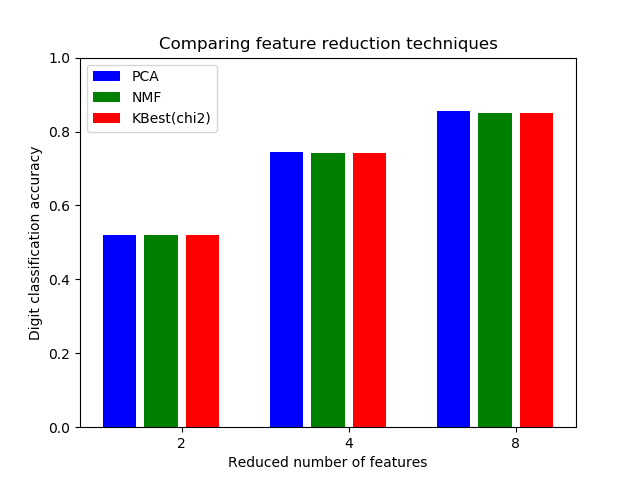使用Pipeline和GridSearchCV選擇降維算法?
本示例構建了一個進行降維處理,然后使用支持向量分類器進行預測的管道。 它演示了如何使用GridSearchCV和Pipeline在單個CV運行中優化不同類別的估計量–在網格搜索過程中,將無監督的PCA和NMF降維與單變量特征進行了比較。
此外,可以使用memory參數實例化管道,以記住管道內的轉換器,從而避免反復安裝相同的轉換器。
請注意,當轉換器的安裝成本很高時,使用內存來啟用緩存就變得很有趣。
管道和GridSearchCV的展示
本節說明了將Pipeline與GridSearchCV一起使用。
# 作者: Robert McGibbon, Joel Nothman, Guillaume Lemaitre
import numpy as np
import matplotlib.pyplot as plt
from sklearn.datasets import load_digits
from sklearn.model_selection import GridSearchCV
from sklearn.pipeline import Pipeline
from sklearn.svm import LinearSVC
from sklearn.decomposition import PCA, NMF
from sklearn.feature_selection import SelectKBest, chi2
print(__doc__)
pipe = Pipeline([
# the reduce_dim stage is populated by the param_grid
('reduce_dim', 'passthrough'),
('classify', LinearSVC(dual=False, max_iter=10000))
])
N_FEATURES_OPTIONS = [2, 4, 8]
C_OPTIONS = [1, 10, 100, 1000]
param_grid = [
{
'reduce_dim': [PCA(iterated_power=7), NMF()],
'reduce_dim__n_components': N_FEATURES_OPTIONS,
'classify__C': C_OPTIONS
},
{
'reduce_dim': [SelectKBest(chi2)],
'reduce_dim__k': N_FEATURES_OPTIONS,
'classify__C': C_OPTIONS
},
]
reducer_labels = ['PCA', 'NMF', 'KBest(chi2)']
grid = GridSearchCV(pipe, n_jobs=1, param_grid=param_grid)
X, y = load_digits(return_X_y=True)
grid.fit(X, y)
mean_scores = np.array(grid.cv_results_['mean_test_score'])
# 分數按param_grid迭代的順序排列,按字母順序排列
mean_scores = mean_scores.reshape(len(C_OPTIONS), -1, len(N_FEATURES_OPTIONS))
# 選擇最佳C的分數
mean_scores = mean_scores.max(axis=0)
bar_offsets = (np.arange(len(N_FEATURES_OPTIONS)) *
(len(reducer_labels) + 1) + .5)
plt.figure()
COLORS = 'bgrcmyk'
for i, (label, reducer_scores) in enumerate(zip(reducer_labels, mean_scores)):
plt.bar(bar_offsets + i, reducer_scores, label=label, color=COLORS[i])
plt.title("Comparing feature reduction techniques")
plt.xlabel('Reduced number of features')
plt.xticks(bar_offsets + len(reducer_labels) / 2, N_FEATURES_OPTIONS)
plt.ylabel('Digit classification accuracy')
plt.ylim((0, 1))
plt.legend(loc='upper left')
plt.show()
輸出:
 在管道中緩存轉換器
在管道中緩存轉換器
有時值得存儲特定轉換器的狀態,因為它可以再次使用。 在GridSearchCV中使用管道會觸發這種情況。因此,我們使用參數內存(memory)來啟用緩存。
警告:請注意,此示例僅是示例,因為在這種特定情況下,擬合PCA不一定比加載緩存慢。 因此,當轉換器的安裝成本很高時,請使用內存構造函數參數。
from joblib import Memory
from shutil import rmtree
# 創建一個臨時文件夾來存儲管道的轉換器
location = 'cachedir'
memory = Memory(location=location, verbose=10)
cached_pipe = Pipeline([('reduce_dim', PCA()),
('classify', LinearSVC(dual=False, max_iter=10000))],
memory=memory)
# 這次,將在網格搜索中使用緩存的管道
# 退出前刪除臨時緩存
memory.clear(warn=False)
rmtree(location)
僅在評估LinearSVC分類器的C參數的第一配置時計算PCA擬合。 ‘C’的其他配置將觸發緩存PCA估計器數據的加載,從而節省了處理時間。 因此,當安裝轉換器成本高昂時,使用內存對管道進行緩存非常有用。
腳本的總運行時間:(0分鐘5.976秒)
